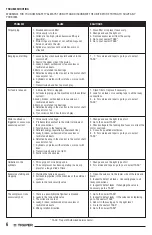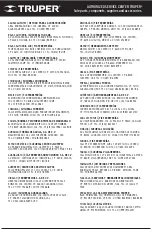
5
EVERY FOUR MONTHS
OR AFTER 500 HOURS
USE
OIL: Drain oil and refill up
to the right level using
SAE-30 motor oil. (See
figure H)
GENERAL MAINTENANCE
CLEANSING:
Keep the
inside and outside of the
compressor
clean.
Replace oil regularly and
keep all the external
surfaces clean. A clean
inner side guarantees
good mechanical
efficiency and a clean
exterior allows circulating
air heat to dissipate
efficiently. (See figure I).
SUCTION ACTION:
Put your hand lightly onto the filter admission
orifices. You will clearly hear the air suction. A deficient suction
suggests the air filter is blocked or the admission valves are
damaged. (See figure J).
PISTON RINGS:
The
sealing rings and the
oil-scraper ring shall be
inspected when the motor
is using oil in excess. It
indicates the rings are
worn and need to be
replaced. When replacing
rings or other major
components always
change oil.
These types of adjustments must be carried
out in a Truper Authorized Service center.
BEARINGS:
When reviewing or changing the piston rings, the
crankshaft bearings and the compressor rod must also be
checked to determine if they are worn, and replace them if
necessary.
OVERLOAD PROTECTION:
The compressor is built with a
thermal-magnetic protector that prevents the motor from
excessive heating. The engine shuts down when the switch is
activated (See figure K), to reset the engine, follow these steps:
1.- Press the switch to ensure that the compressor is off.
2.- Let the compressor cool down for at least 5 minutes.
3.- Press the thermal switch located on the upper cover of the
engine.
4.- Lift the switch to start the compressor.
NOTE:
If the unit shuts down again, please go to a Truper
Authorized Service Center.
MOTOR TRANSMISSION PULLEY
Isolate power and remove the guard and belt. The pulley can be
removed using an extractor known as “Ouller”. Do not use a
hammer to hit the pulley and remove from the shaft. It could
damage the motor bearings.
MOTOR: If the motor does not start or stops during operation
not necessarily means there is something wrong with the motor.
A “buzzing” motor may indicate:
a) Voltage drops in the feeding line or loose connections.
b) Leaks in the check valves causing counter-pressure from the
receptor.
c) Wrong starting procedure is being used (See Start up and
Automatic Operation).
d) Compressor pump is “stiff” due to lack of oil.
An apparently “dead” motor may indicate:
a) The thermal overload protection device was activated.
b) Power supply fuses blew.
c) Loose connection.
ELECTRIC DIAGRAM
I
K
Z2
U1
U2
V1
C1
C2
V2
Z1
~V
Z2
U1
U2
V1
C1
C2
V2
Z1
~V
CW
CCW
H
J
NOTE





































